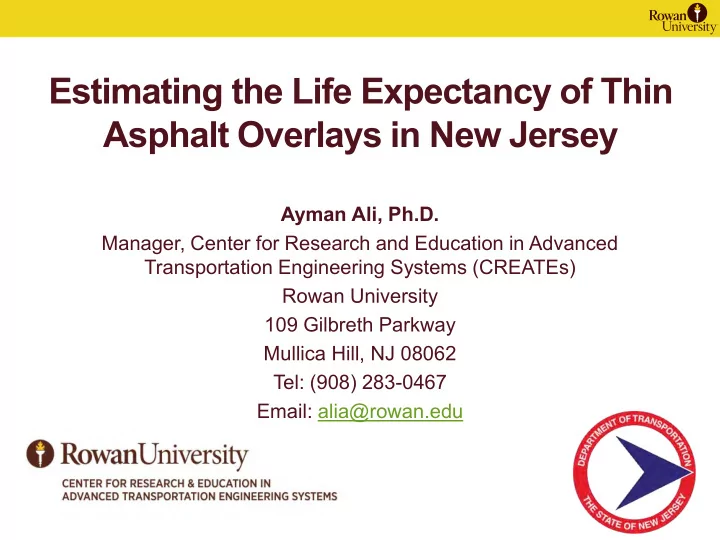

Instrumentation Instrumentation of NJDOT Sections: ASGs 65
Instrumentation Instrumentation of NJDOT Sections: ASGs 66
All Sections 67
Testing Plan 68
HVS Testing Protocol One section, out of the six, will be subjected to loading using the HVS until failure (i.e., failing one section at a time). Air Temp. around section is controlled using CREATEs Cooling/Heating System (25 o C). Therefore, HVS loading will be conducted in the following sequence: Section 1 loaded until failure, followed by Section 2, followed by Section 3, and so on. 9.5ME SMA HPTO 95/BRIC SMA/BRIC HPTO/BRIC 1 to 2 1 to 2 1 to 2 1 to 2 1 to 2 1 to 2 Months Months Months Months Months Months 69
Testing Plan 70
Field Testing Steps Perform HWD Testing Verify Sensor Condition Mark Loading Zone Cover Test Section 71
Field Testing Steps Perform Profile Testing Apply Sealing in HVS Station Cooling Trailer 72
Field Testing Steps Ensure Testing Strip is Station HVS on Section Aligned Install Thermostat for Heaters Heat Control Thermostat 73
Field Testing Steps Set-up Data Acquisition Apply Side Insulation Station Apply Rain Covers Attach Cooling Hoses 74
Heating System Contains infrared heating elements. Heating angle can be adjusted depending on desired heating coverage within the section. Used for controlling the air temperature around section (within sealed enclosure). Temperature Range: Depends on ambient temperature. On average, it can maintain the air temperature around the pavement to up to 120 o F. 75
Heating System 76
Cooling System Based on a vapor compression refrigeration cycle (i.e., uses a refrigerant to cool). Works by cycling air through the enclosure covering the HVS. As a result, it is also used for controlling the air temperature around section (within sealed enclosure). Temperature Range: Depends on ambient temperature. On average, it can maintain the air temperature around the pavement to (comfortably) 32 o F. 77
Cooling System 78
Cooling System 79
Data Collection Protocol The CREATEs cDAQ system will be utilized to collect data from all sensors after the application of the following load passes: Data Sampling Frequency 1, 5, 10, 20, 30, 40, 50, 60, 70, 80, 90, 100, 125, 150, 175, 200, 250, 300, 350, 400, 450, 500, 600, 700, 800, 900, 1000, 1200, 1400, 1600, 1800, 2000, 2500, 3000, 3500, 4000, 4500, 5000, 6000, 7000, 8000, 9000, 10000, … Incremented by 5,000 after 10k Incremented by 10,000 after 40k Incremented by 20,000 after 100k Incremented by 40,000 after 200k 80
HWD Testing A field test that is typically conducted evaluate the structural integrity of pavements. The HWD “drops” (freefall) a weight on a particular location. Geophones (seven) are used to measure deflections at various locations: Forming a Deflection Basin. 81
HWD Testing Heavy Weight Deflectometer (HWD) testing will be conducted before HVS loading and after failure. Six locations will be tested on each section. 5 ft. 5 ft. 5 ft. 5 ft. 5 ft. 5 ft. 12 ft. 82
HWD Testing HWD Test Configurations Parameter Types No. of Drops Stress (psi) Load (lbf) Seating 3 60, 85,110, 140 7k, 9.5k, 12.5k, 16k Drop height 1 4 60 7k Load Drop height 2 4 85 9.5k Drop height 3 4 110 12.5k Drop height 4 4 140 16k Loading Plate Diameter 12 in. 83
Transverse Laser Profilometer Characterizes the transverse profiles of pavements. Uses a laser distance measuring device and collect data every 2 mm. Useful in measuring permanent deformation (rutting) within the pavement structure. 84
Transverse Laser Profilometer Transverse profiles will be measured using a laser profilometer on daily basis. Seven locations will be tested as shown in the schematic below: 5 ft. 5 ft. 5 ft. 5 ft. 5 ft. 5 ft. 12 ft. 85
Visual Inspection and Mapping In addition, visual inspection will be conducted to collect information about the section. That is, crack maps and pictures of cracks as loading progresses. 86
Visual Inspection and Mapping 87
Visual Inspection and Mapping 88
Preliminary Testing Results 89
Section Temperature (Before Testing) 4 ft. 1 ft. 2 ft. 7 ft. 12 ft. 90
Temperature (Surface Thermocouples) 4 ft. 1 ft. 2 ft. 7 ft. 12 ft. 91
Temperature (HMA Embedded Thermocouples) Loading 92
Soil Compression Gauge (Gauge 1) Loading 93
Soil Compression Gauge (Gauge 2) Loading 94
Soil Compression Gauge (Gauge 2) Slab 1 Slab 2 Loading 95
LVDT 1 (Horizontal Joint Opening) Loading 96
LVDT 2 (Horizontal Joint Opening) Loading 97
Pressure Cell Loading 98
HWD Testing (Deflection Basins) 5 ft. 3 5 5 ft. 5 ft. 4 6 5 ft. 5 ft. 2 1 5 ft. 12 ft. 99
Final Remarks 100
Recommend
More recommend